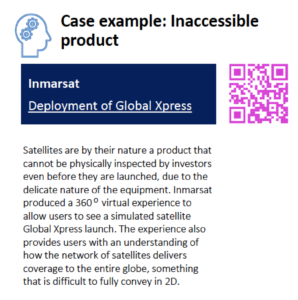Bored of conventional corporate reporting? Tired of flicking through page after page of bland corporate statements and charts? Well, technology experts at a UK financial watchdog might have an answer: the use of virtual and augmented reality (VR and AR).
While both immersive technologies may be better known for enabling users to fly through space, shoot aliens or even see dinosaurs walking down their own high street, a new report concludes that they also have the potential to transform corporate statements.
The study, from the Financial Reporting Lab of the Financial Reporting Council, concludes that examples found by researchers— including brands such as VW, Burberry and Nestlé—“have a place” in the future of disclosures.
“The ability for VR and AR to bridge between the physical and the digital gives it a useful role in supporting and building understanding about a company, its business model and its operations at a distance and scale,” the report says.
‘Beyond watching to experiencing’
It’s worth considering what AR and VR do. Augmented reality generally overlays images on a real landscape. Pokemon Go, for example, can allow users to find cartoon characters in their local parks. Virtual reality provides simulated worlds in 3D, often viewed through specialist goggles.
Both have uses beyond gaming. Augmented reality applications have been developed to help passengers navigate Gatwick Airport, while Ikea has an app that allows a customer to scan their room then redesign it using the store’s products.
Real-world applications of virtual reality include Spatial, described by some as a virtual reality version of Zoom, while the training and education sector has seen a boom in the provision of VR applications including some for surgeons (warning for those of a sensitive disposition: If you watch the demo videos online the wounds can appear very real indeed).
But the Lab sees the potential for company reporting and believes AR and VR can provide an “alternative to physical meetings”, site visits for mass audiences and even peeking into the internal workings of a production line.

They also believe they could prove ideal for delivering “emotive subjects” such as sustainability and corporate purpose messages. “VR and AR moves beyond watching to experiencing within the narrative,” the report says.
Helpfully, the FRC offers a selection of QR codes so readers can use their smartphones to visit some prime examples of companies using the technology.
Inmarsat’s VR presentation (see the QR code) allows viewers to watch the launch of a satellite from space; Zalando, the online fashion store, offers a visit to a virtual town; Audi, the automaker, offers inspection of a production plant; Nestlé delivers a tour inside its company museum. The images are arresting and immersive, offering an experience that goes far beyond browsing printed pages.
The FRC report says: “The current and potential examples in this report drive us to conclude that VR and AR do have do have a place in a more pluralistic suite that is the future of corporate reporting.”
VR and AR in financial reporting
But while the examples from the Lab report provide for a dramatic experience, purists will be quick to point out that none of them present numbers. Bringing the financials to life may be a little way off, as yet.
Mike Suffield, director of professional insights at ACCA, embraces the technology but also warns that it’s not enough on its own.
“Using AR and VR has huge potential, but we need to make sure sure corporate reporting is trusted, complete and that it provides the overview stakeholders and shareholders need. Corporate reporting still needs the human touch and the expertise of accountants,” he says.
Corporate reporting has every opportunity to come to life using new technology. It won’t be cheap. And it may take some imagination to make the numbers sing. Or even dance.





